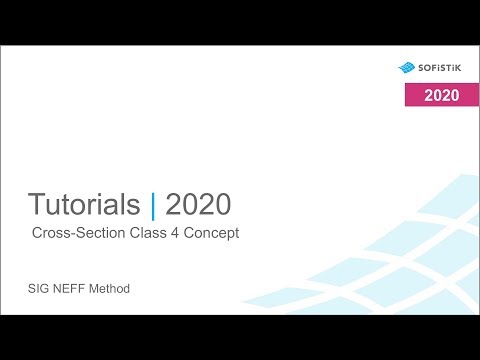Cross-section class 4 concept#
Introduction#
This document provides a short introduction to the cross-section class 4 workflow in SOFiSTiK.
This project is fully done using Graphical User Interface (GUI). However, it could be completely reproduced via text input - CADINP language. The intention of this tutorial is to guide you through a simple one-column example and introduce the general work-flow for cross-section class 4 in SOFiSTiK.
Hint
This tutorial is based on EN 1993-1-1 and EN 1993-1-5.
Tip
If you click on the figure it will show up in original size.
Objectives#
In SOFiSTiK there are two approaches to calculate cross-sections with a cross-section class 4. First approach is to use the SIG NEFF method, the second approach is to use the iterative method.
SIG NEFF (effective properties in AQUA)
Iterative Method (iteration of effective properties by using the real stresses)
Export effective cross-section properties to Excel via ResultViewer
Visualize the results via ResultViewer
See also
VERiFiCATiON Manual Design DCE-EN30 Steel column with a class 4 cross-section:
PDF files: dce-en30.pdf
Input files: dce-en30.zip
Project Description#
Geometry#
The cross-section class 4 concept will be shown on a simple one column example.
SIG NEFF method#
By using the NEFF SIG SMIN method it is possible to define only one effective cross-section for the design and stability check, therefore the effective section modulus is determined assuming that the cross-section is subject only to stresses due uniform axial compression.
Hint
This approach checks the MOST UNFAVOURABLE case where all plates are under compression. By using this method it is possible to use the effective properties for post-processing (ResultViewer, Excel).
Title: SIG NEFF Workflow for Cross-Section Class 4 | Quality: 1080p Full HD | Captions: English
Important
SIG NEFF for thin-walled cross-sections: The support condition of the end of the plate elements in a thin-walled section cannot be controlled with additional stress points, but prescribing the fixities with items FIXB and FIXE in command PLAT.
After the cross-section with the effective properties is created. You may use it as a normal cross-section for further cross-section resistance and stability checks.
Via Graphical User Interface only the case where the cross-section is subjected to stresses due uniform axial compression can be calculated.
By using the CADINP input (text based) you may control the position of the null line by defining the SMIN stresses for node (YMIN,ZMIN) and SMAX stress for node (YMAX,ZMAX).
Below you will see a simple example
+PROG AQUA
HEAD Materials and Cross-Section
NORM EN 199X-200X
ECHO SECT EXTR
STEE 1 S 275
LET#B 600-10/2-10/2
LET#H 600-20/2-10/2
LET#T 10
SECT 1 MNO 1 BET "SH"
PLAT NO YB ZB YE ZE T
1 -#B/2 -#H/2 +#B/2 -#H/2 #T
2 +#B/2 -#H/2 +#B/2 +#H/2 #T
3 +#B/2 +#H/2 -#B/2 +#H/2 #T*2
4 -#B/2 +#H/2 -#B/2 -#H/2 #T
! Control stresses position (null line)
NEFF SIG YMIN 0 ZMIN -300 YMAX 0 ZMAX 300 SMIN -200 SMAX 200
END
By defining the input above the program will set stress SMIN=-200 MPa (compression) to node (YMIN,ZMIN)=(0,-300) mm and stress SMAX=200 MPa (tension) to node (YMAX,ZMAX)=(0,300) mm
Iterative method#
By using the iterative method (EN 1993-1-5) for calculating the effective cross-section properties, the effective CS properties will be calculated for the current stress state, so it gives more realistic and economical results.
Important
The iterative method can be used ONLY for the THIN-WALLED cross-sections.
The iterative method will be automatically activated in the task “Steel - Resistance of Cross Sections” if the design option “Nonlinear Stress with Strain Hardening” is selected.
Title: Iterative Method Workflow | Quality: 1080p Full HD | Captions: English

